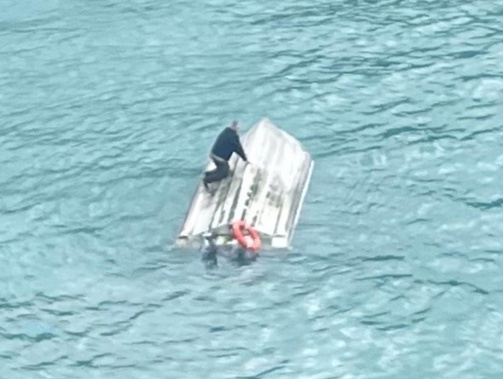
Maritime New Zealand will not be laying charges against anyone in relation to the five people killed after a boat capsized near Kaikōura.
In releasing its decision, Maritime New Zealand has confirmed the likely cause of the capsize was a whale impacting the i-catcher as it came up to the surface.
The skipper - who spoke for the first time today about the tragedy to the Herald - and five passengers were rescued from atop the boat.
But five were trapped under it and died after being exposed to petrol fumes in September last year.
They were Catherine Margaret Haddock, 65, and Susan Jane Cade, 63, of Lower Hutt, Diana Ruby Stewart, 68, Peter Charles Hockley, 76, and Maureen Patricia Pierre, 75, of Christchurch.
Maritime New Zealand’s deputy director regulatory operations, Deb Despard, said that following the investigation, Maritime NZ has decided not to take any prosecution action against any individuals or organisations.
The skipper and his wife provided a short comment to the Herald after the MNZ report went public.
Mark and Sharlene Ealam said they were “pleased that the MNZ investigation has been completed”.
”(We) note the Transport Accident Investigation Commission investigation is still in progress and hope that too will be finalised soon.,” they said.
”But thoughts and condolences today are with the other survivors and the family and friends of those who died.”
/cloudfront-ap-southeast-2.images.arcpublishing.com/nzme/K5URIYJVAVX46W5UA57ALIGASE.jpg)
Photo from a helicopter circling the charter boat that capsized near Kaikōura, killing five people.
“The investigation undertaken by Maritime NZ specialist investigators was complex and fulsome.
“It involved visiting the scene, reviewing the conditions from that day, interviewing witnesses, commissioning an independent survey of the vessel, checking the safety equipment for the vessel, collating and reviewing the operator’s documentation.”
The survivors, families of the victims, and those involved had been informed of the decision not to prosecute any of the parties involved.
/cloudfront-ap-southeast-2.images.arcpublishing.com/nzme/KAPJPYRG5RG65J3CZV7YICJK5M.jpg)
Susan Cade, a kayaker, dancer and photographer who passed away in Kaikoura boating tragedy. Picture / Supplied
“The investigation looked at the potential cause for the vessel to capsize, the fuel leak, and how the organisations and individuals involved managed their responsibilities,” she said.
After reviewing accounts from survivors, receiving feedback from witnesses in the area, and technical analysis of the force required to cause a vessel of this size to roll over, the investigation identified the “likely cause of the capsize” was a whale impacting the i-Catcher as it came up to the surface.
TAIC arlier revealed part of its preliminary report into the Kaikōura boat tragedy as it found “urgent” safety issues that need to be addressed.
TAIC revealed the boat had leaked petrol into the air pocket, which likely reduced the chances of survival for those inside it.
“All of the deceased showed symptoms of petrol exposure consistent with inhalation.”
Being exposed to petrol in a confined space reduces survivability as petrol attacks the cardiac and central nervous systems.
“In low concentration levels, people can experience the smell and irritation of the eyes and upper respiratory tract. High levels of exposure can rapidly lead to confusion, loss of consciousness and sudden death,” the report read.
When the boat capsized, two people were ejected from the vessel and eight were initially in the air pocket.
The skipper and two others swam out immediately, but one other person surfaced under the hull and tried to tell the others under it to swim out. They noticed the air “did not feel good” and swam out from under the boat.
The police dive squad, who entered the air pocket later noticed a “very strong” smell of petrol.
Chief investigator of accidents Naveen Kozhuppakalam said the petrol had almost certainly leaked from flaws in the fuel system.
“A pipe connected to the secondary fuel tank vent hose had a hole that was the main source of leaked fuel. It presented a hazard that risked fire or explosion if the fuel leaked when filling the tank, or risked fumes in the air pocket if the boat overturned.”
Chief commissioner Jane Meares said the issue goes further than just the i-Catcher.
“It’s nation- and system-wide. Everyone on board a boat deserves to be safe.”
Despard said Maritime NZ was “prioritising work on guidance for the industry” to remind them about considerations raised TAIC report.
“This includes working with recognised maritime surveyors to ensure they are looking for the right issues when surveying vessels.
“Our targeted advice to the sector and surveyors will make a difference by improving the understanding of potential risks around fuel systems,” Despard said.
As part of the follow-up work after this incident, Maritime NZ was looking at on-the-water safety initiatives skippers and crew on trips such as this can undertake to assist those on board should something the vessel encounter trouble.
“Our people are currently working on advice and we expect it to go to the sector in the coming months,” Despard said.
“We understand this may be an emotional time for those involved. Maritime NZ wishes to extend its condolences to those impacted by this tragedy.”
Sam Sherwood is a Christchurch-based reporter who covers crime. He is a senior journalist who joined the Herald in 2022, and has worked as a journalist for 10 years.
Take your Radio, Podcasts and Music with you









